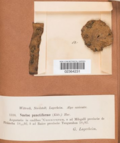Nostoc, also known as star jelly, troll's butter, spit of moon, fallen star, witch's butter (not to be confused with the fungi commonly known as witches'...
24 KB (1,469 words) - 16:27, 6 December 2023
Nostoc commune is a species of cyanobacterium in the family Nostocaceae. Common names include star jelly, witch's butter, mare's eggs. It is the type species...
6 KB (595 words) - 10:17, 22 May 2024
Nostoc verrucosum is a species of cyanobacteria usually found in colonies and in globose racks. It has a greenish to blackish color. It grows in creek...
2 KB (220 words) - 14:57, 6 January 2022
Nostoc pruniforme (Mare's eggs) are a species of cyanobacterium. These freshwater bacteria grow in colonies which take the form of dark green, gelatinous...
2 KB (258 words) - 03:57, 21 July 2023
Nostoc punctiforme is a species of filamentous cyanobacterium. Under non-limiting nutritional environmental conditions, its filaments are composed of photosynthetic...
3 KB (261 words) - 03:10, 30 October 2023
Fat choy (redirect from Nostoc flagelliforme)
Chinese: 髮菜; simplified Chinese: 发菜; pinyin: fàcài; Jyutping: faat³ coi³; Nostoc flagelliforme) is a terrestrial cyanobacterium (a type of photosynthetic...
9 KB (736 words) - 14:00, 8 February 2024
tissue, three as muscle, and two as cartilage. Brandeis's Nostoc theory relied on the fact that Nostoc expands into a clear jelly-like mass when rain falls...
10 KB (906 words) - 22:19, 11 August 2024
Nostoc thermotolerans was a newly isolated strain of cyanobacteria cultured in Mandsaur, Madhya Pradesh, India as of 2017. In habitat, these cyanobacteria...
2 KB (263 words) - 23:35, 16 May 2024
Nostoc Lake is a lake lying 1 nautical mile (1.9 km) southwest of Mount Provender in the west part of the Shackleton Range. It was first mapped in 1957...
3 KB (70 words) - 01:41, 29 April 2022
Nostoc parmelioides is a species of cyanobacterium in the family Nostocaceae. It is notable for its symbiosis with a midge larva, Cricotopus nostocicola...
1 KB (60 words) - 02:15, 9 January 2024
Péwé Peak (redirect from Nostoc Flats)
flat glacial outwash plain, the surface of which is covered by the algae Nostoc. The feature is located east of the south lobe of Joyce Glacier. So named...
6 KB (839 words) - 08:33, 14 June 2024
been colonised by Nostoc spp., In 1991, Ganther and others isolated diverse heterocystous nitrogen-fixing cyanobacteria, including Nostoc, Anabaena and Cylindrospermum...
179 KB (17,664 words) - 20:32, 24 August 2024
formed during nitrogen starvation by some filamentous cyanobacteria, such as Nostoc, Cylindrospermum, and Anabaena. They fix nitrogen from dinitrogen (N2) in...
13 KB (1,507 words) - 21:11, 13 May 2024
mycorrhiza. Geosiphon pyriformis is known for being the symbiont of Nostoc. The Geosiphon-Nostoc symbiosis, as by modern definitions, is not a lichen, since it...
7 KB (826 words) - 07:47, 13 August 2023
believed the material to be "something vomited up by birds or animals". Nostoc, a type of fresh water blue-green algae (cyanobacteria) forms spherical...
24 KB (2,920 words) - 07:47, 27 June 2024
Nostoc commune var. sphaeroides is an edible cyanobacterium found in diverse habitats such as lakes and rivers. It is used as a food and nutritional supplement...
2 KB (156 words) - 09:03, 25 February 2021
parenchymatous cells. Anthoceros species are host to species of Nostoc, a symbiotic relationship in which Nostoc provides nitrogen to its host through cells known as...
10 KB (744 words) - 22:29, 1 December 2023
cyanobacteria symbioses, in particular that between cyanobacteria of the genus Nostoc and their hosts. In response to a hormogonium-inducing factor (HIF) secreted...
2 KB (175 words) - 14:36, 2 October 2021
for both the fungal partner (mycobiont) of Peltigera membranacea and its Nostoc photobiont partner; these allow for both population genetic studies and...
2 KB (156 words) - 19:40, 28 January 2023
least some species of Gunnera host endosymbiotic cyanobacteria such as Nostoc punctiforme. The cyanobacteria provide fixed nitrogen to the plant, while...
27 KB (2,357 words) - 23:01, 29 July 2024
Jean-Pierre P. (3 August 2015). "Provision of water by halite deliquescence for Nostoc commune biofilms under Mars relevant surface conditions". International...
47 KB (3,687 words) - 07:32, 2 July 2024
original (1866) conception of the three kingdoms of life, including the new kingdom Protista. Notice the inclusion of the cyanobacterium Nostoc with plants....
74 KB (4,819 words) - 10:13, 22 July 2024
the two symbionts, a species of Nostoc. The other is a species of Coccomyxa. These perform photosynthesis, and the Nostoc also fixes nitrogen. The lichen...
4 KB (302 words) - 20:47, 12 January 2024
limnetica A. macrospora macrospora A. macrospora robusta A. monticulosa A. nostoc A. oscillarioides A. planctonica A. raciborskii A. scheremetievi A. sphaerica...
9 KB (779 words) - 22:04, 29 December 2023
Haskard Highlands (section Nostoc Lake)
The Haskard Highlands (80°30′S 29°15′W / 80.500°S 29.250°W / -80.500; -29.250) are a range of peaks and ridges between Blaiklock Glacier and Stratton...
7 KB (1,047 words) - 22:37, 25 July 2024
Shackleton Range (section Nostoc Lake)
The Shackleton Range (80°30′S 25°00′W / 80.500°S 25.000°W / -80.500; -25.000) is a mountain range in Antarctica that rises to 1,875 metres (6,152 ft)...
24 KB (3,567 words) - 14:29, 1 February 2024
cyanobacteria as their partner. The most commonly occurring cyanobacterium genus is Nostoc. Other common cyanobacterium photobionts are from Scytonema. Many cyanolichens...
130 KB (14,225 words) - 16:44, 20 August 2024
Nostoc genus. The virus was first isolated by Kenneth Adolph and Robert Haselkorn in 1971 in the US, from the nitrogen-fixing cyanobacterium, Nostoc muscorum...
4 KB (467 words) - 06:07, 5 January 2024
Microcystins Liver Microcystis, Anabaena, Planktothrix (Oscillatoria), Nostoc, Hapalosiphon, Anabaenopsis Nodularins Liver Nodularia Alkaloids Anatoxin-a...
47 KB (5,161 words) - 10:19, 16 August 2024
F, Lamerdin J, Predki P, Atlas R (2001). "An overview of the genome of Nostoc punctiforme, a multicellular, symbiotic cyanobacterium". Photosynthesis...
80 KB (7,347 words) - 15:48, 17 August 2024























